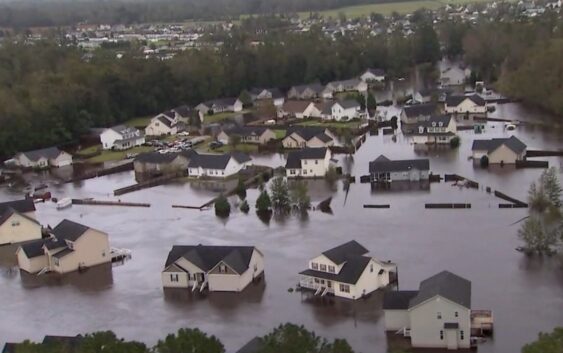- They couldn’t save their daughters’ lives in the July 4 floods. Now they’re dealing with the grief and the guilt.
- Austin could see heavy rains, possible flooding over the next few days
- Families of campers, counselors who died in Texas Hill County floods sue Camp Mystic
- Small plane bound for Jamaica with hurricane relief supplies crashes in Florida neighborhood
- Ask the Meteorologist: Did a tornado hit Johnston County Saturday night?
History with ‘Hud’: Impactful Cape Fear hurricanes which were subsequently retired

WILMINGTON, NC (WWAY) — Hurricane Season kicks off on Sunday, marking the start of a 182-day stretch of prime hurricane formation conditions from June 1 through November 30.
While the Cape Fear has been hit by countless memorable storms over the years, only a select few have been deemed worthy of being retired forever.
In all, since naming tropical systems began in 1953, there have been 99 storms to be retired from use due to causing catastrophic damage or loss of life somewhere bordering the Atlantic Basin. Of those, just five were taken out of use due to the affect they had on our region.
The first storm to be retired after making landfall in the Cape Fear came the second year of naming storms, being Hurricane Hazel in 1954. The category 4 storm remains the strongest on record to strike the area, coming ashore early on October 15 near Calabash.
Winds of around 140 miles per hour were estimated in Oak Island, with a storm surge as high as 18 feet devastating Calabash itself. In Long Beach, only 5 of the 357 pre-storm buildings were left standing, and every pier along a 170-mile stretch of the coast was destroyed.
The Cape Fear was spared of particularly destructive or deadly systems worthy of retirement until 1996, when Hurricane Fran roared ashore.
Fran made landfall as a weakening category 3 near Bald Head Island and Southport with winds near 115 miles per hour in the evening of September 5. Fran was responsible for 26 deaths and at the time was the most expensive natural disaster in NC history.
Damage along the coast from Wrightsville Beach up to Topsail Island took place due to the strong winds and storms surge as high as 12 feet. Wilmington saw around 75 percent of homes sustaining some amount of damage, including the toppling of the First Baptist Church steeple in downtown along Market Street.
Just three years later, Hurricane Floyd would add to the list of hurricanes impactful enough to be retired.
Floyd made landfall in the early morning hours of September 16 with sustained winds near 105 miles per hour, making it a category two storm. The widespread rainfall and catastrophic flooding left 36 people dead in North Carolina with total storm damage estimated near $6.5 billion.
Locally, Floyd destroyed 7,000 homes, left 17,000 homes uninhabitable, and damaged another 56,000 structures. In Wilmington, Floyd holds the record for the lowest barometric pressure ever measured at 959.7 millibars and the largest one-day rainfall at 13.38 inches.
A little less than two decades later saw Hurricane Matthew paying a visit to the region on October 8, 2016.
Landfall took place across the border in South Carolina as just a category 1 storm, but the big story was deadly flooding from excessive rainfall from more than a foot of rainfall. The system also brought bad beach erosion to Oak Island and Ocean Isle Beach, where there was water flowing beneath homes.
A 150 foot portion of the Oak Island pier was also torn off during the height of the storm surge event.
But as bad as it was, nothing compared to Hurricane Florence and the impacts it would have two years later.
The system crept ashore in Wrightsville Beach at 7:15 in the morning of September 14, 2018. The storm moved at just a few miles per hour, meandering around the region for days and dumping more than 30 inches of rain in a few locations.
Areas still recovering from devastating flooding two years before were struck once again by an even bigger flooding system, causing Florence to forever be retired from the list of available hurricane names.
The most recent landfalling hurricane in the Cape Fear was Isaias. But it wasn’t retired and will be used again in the 2026 season.
Only time will tell how bad this season will be. But hopefully we won’t see any storms which will be so bad they’re never used again.
Meteorologist Matthew Huddleston (‘Hud’) has always had two major loves – weather and history. While you can watch him talk about weather each morning on WWAY, he looks forward to bringing you a little piece of history each Thursday on WWAY’s website.
To read other History with ‘Hud’ segments, click HERE.